In cooperation with the NPSP Council, SAGE designed a smart school crossing outside of St Joseph’s Memorial School on William Street, Norwood, providing enhanced safety for students in and out of school hours and adding a layer of analytics for the council.
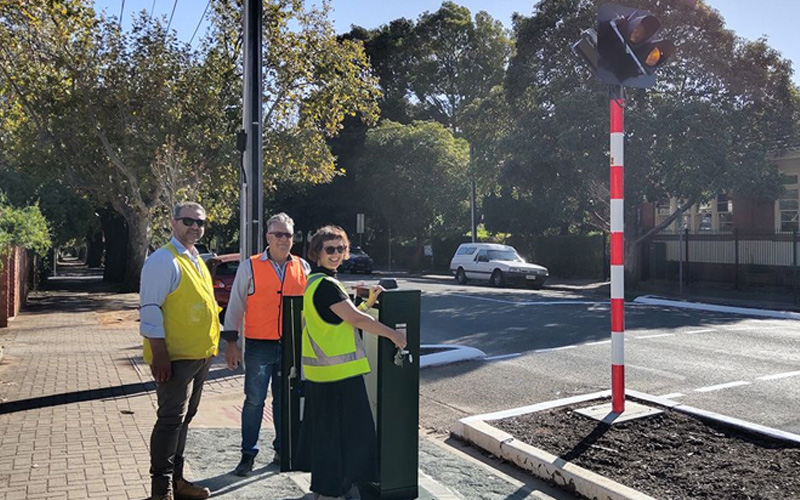 The smart school crossing in Norwood is providing a safer way for students and residents to cross the road.
The smart school crossing in Norwood is providing a safer way for students and residents to cross the road.
The smart school crossing utilises a fusion of installed telemetry hardware to provide real-time metrics on vehicle flow through the crossing and information on the state of the system. Communicating with SAGE Edge – SAGE’s propriety IoT hardware – real-time information is transmitted back to a custom-built CMMS, enabling in-depth data analysis.
SAGE Edge is an IoT capture device that interfaces with a wide variety of Intelligent Transport Systems (ITS) and IoT field devices, which, when combined with CMMS integration allows for remote monitoring, diagnostics, software configuration, field software updates, and data interrogation.
The CMMS uses Ignition SCADA to provide a user-friendly browser-based interface, enabling the remote configuration and management of SAGE Edge via highly customisable dashboards.
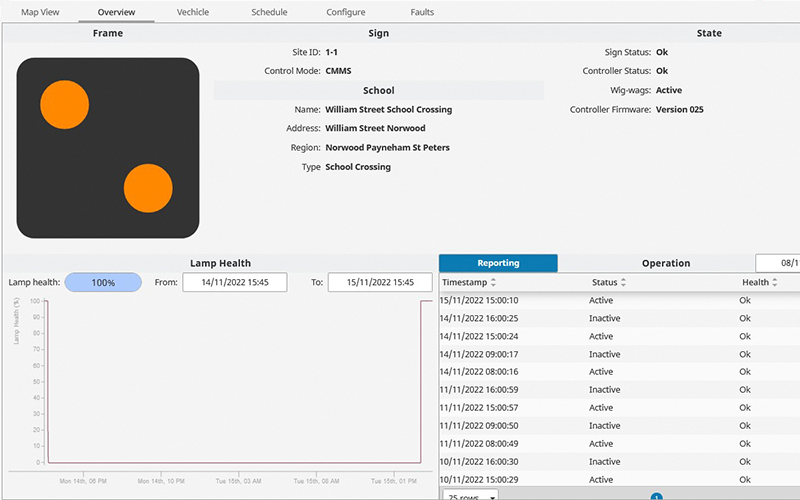 Crossing overview page for the Norwood Crossing.
Crossing overview page for the Norwood Crossing.
The SAGE-built CMMS has enabled the NPSP Council to access historical data, which over a short period of time, can inform decisions around how best to operate the crossing, how effective the crossing is at reducing vehicle speed, and if more action should be taken to reduce the speed of vehicles.
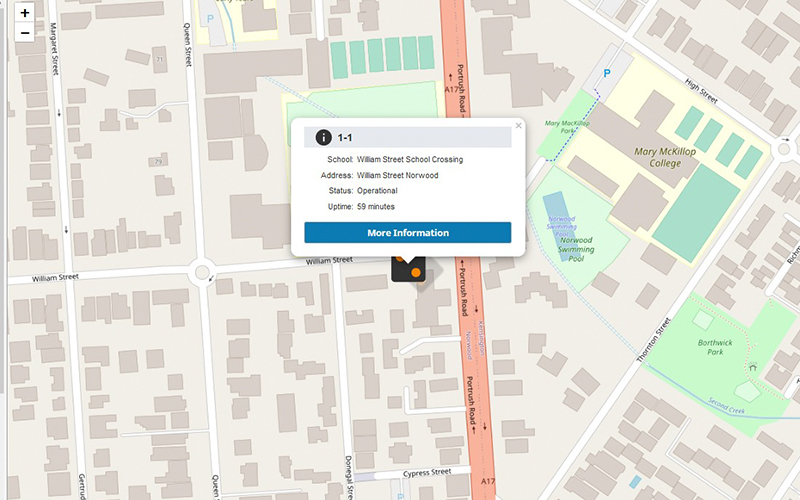 Map view showing the current state of the Norwood crossing.
Map view showing the current state of the Norwood crossing.
The smart school crossing utilises the SAGE Edge and a connected PLC to control the crossing lights using a fully customisable calendar system within the CMMS. Users can configure calendar activation schedules to create plans for all crossings managed by the council, complete with template plans to make calendar design easier.
Each calendar is made up of modular components including holidays, weekly plans, and once-off overrides, enabling a series of calendars with marginal differences to be created for each crossing without having to change the common requirements.
 The schedule creation page enables simplistic scheduling of the smart school zone.
The schedule creation page enables simplistic scheduling of the smart school zone.
SAGE CMMS includes a detailed breakdown of the direction, volume and speed of vehicles moving through the intersection, thanks to an on-site radar integrated into the system. The active period of the lights and the speed of vehicles is used to provide a visual confirmation of whether the activation of the crossing impacts the aggregate speed. Total counts of the eastbound and westbound traffic are visible via the CMMS dashboard (see picture below) along with a bar chart showing the real-time count of the number of vehicles moving at a specific speed.

Vehicle count and speed breakdown dashboard for the William Street school crossing.
A downloadable evidentiary report (pictured below) is also available with additional information for the vehicle throughput showing the vehicle count in each direction, the average speed, the lamp state, and the number of non-compliant vehicles. This detection history is stored in a database with records available up until the previous year, allowing councils to track the real-time flow – providing constant feedback on the impact of the crossing on the community – but also request vehicle metrics for any specific day.
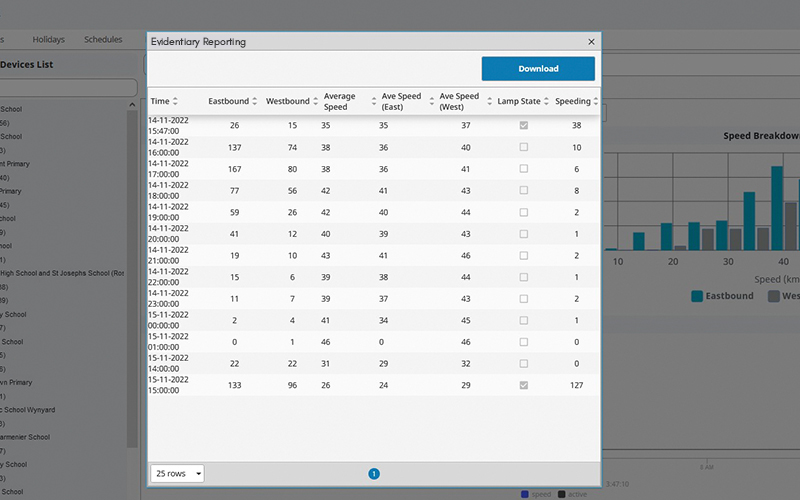 A downloadable evidentiary report containing historic readings from the William Street school crossing.
A downloadable evidentiary report containing historic readings from the William Street school crossing.
To reduce installation costs, a solar charger and panel were installed to isolate the system from the surrounding power grid. Feedback for the current-voltage and current levels of the system is provided via the CMMS to ensure that the power drawn by the system does not exceed that supplied by the solar charger.
The installed sign controller acts as a 4G gateway to ensure that the system can communicate remotely with minimal installation effort. Recognising that the use of the cellular network has the potential for issues to arise in the event of an outage; the system is designed to retain a local record of any system fault or state change to ensure that, even when offline, the crossing activates and operates as configured.
As an additional safeguard, a dual control system was developed as a failsafe to ensure that cellular health would not limit the operation and access to the crossing. To achieve this, in parallel with the CMMS, a local tool was developed for offline diagnosis and monitoring, ensuring that users can monitor and control the system without internet access, so the lamps always remain active and operational when needed.
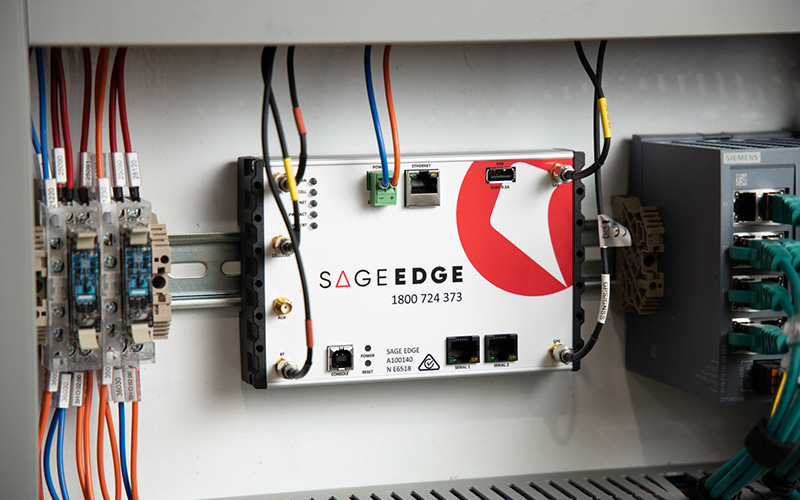 SAGE Edge is an industry-leading technology that can be coupled with additional devices or data sources to deliver valuable insights to the CMMS.
SAGE Edge is an industry-leading technology that can be coupled with additional devices or data sources to deliver valuable insights to the CMMS.
The utilisation of SAGE Edge opens the possibility of expansion for what can be achieved beyond crossing control and monitoring. A universal IoT data capture station, SAGE Edge can be utilised for smart city data collection, transport travel time data, and general IoT data management.
Most effective when used as part of a wider IoT network, the wireless capture station monitors WiFi, Bluetooth, and undiscoverable Bluetooth devices as they travel through the environment, providing councils with an understanding of how traffic flows not just through the crossing but the wider community. Using non-invasive technology, SAGE Edge collects data and integrates it with existing application programming interfaces (APIs) to provide detailed traffic analytics at a reasonable cost.
Integration with Addinsight allowed for the NPSP Council to visualise the flow of traffic between capture stations and gain valuable traffic intelligence. The software solution can generate travel time predictions using a combination of live and historical readings to measure the average travel time of vehicles between stations.
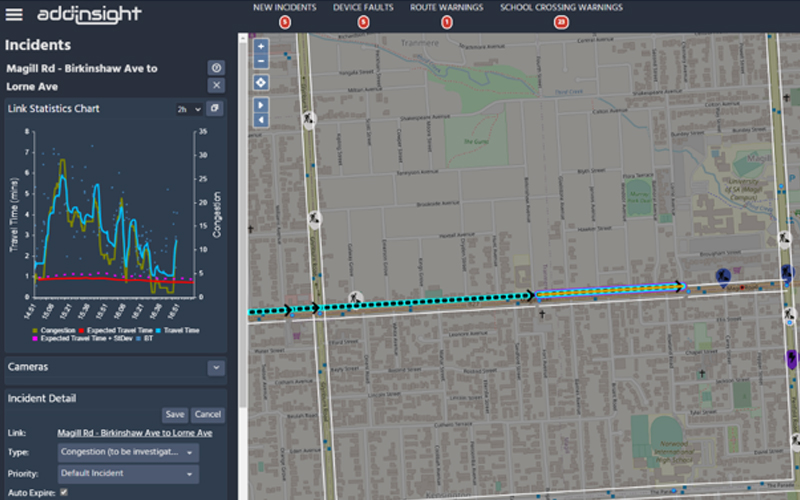 Addinsight interface including travel time and congestion analysis.
Addinsight interface including travel time and congestion analysis.
Addinsight enables the client to identify problems in real-time thanks to comparative analyses of expected travel times with reported travel times. The traffic intelligence system can identify unusual congestion points across the network, highlighting this clearly for the user. This ability to identify unusual and recurring congestion provides a capacity beyond what can be observed when using a single radar at an isolated crossing site.














